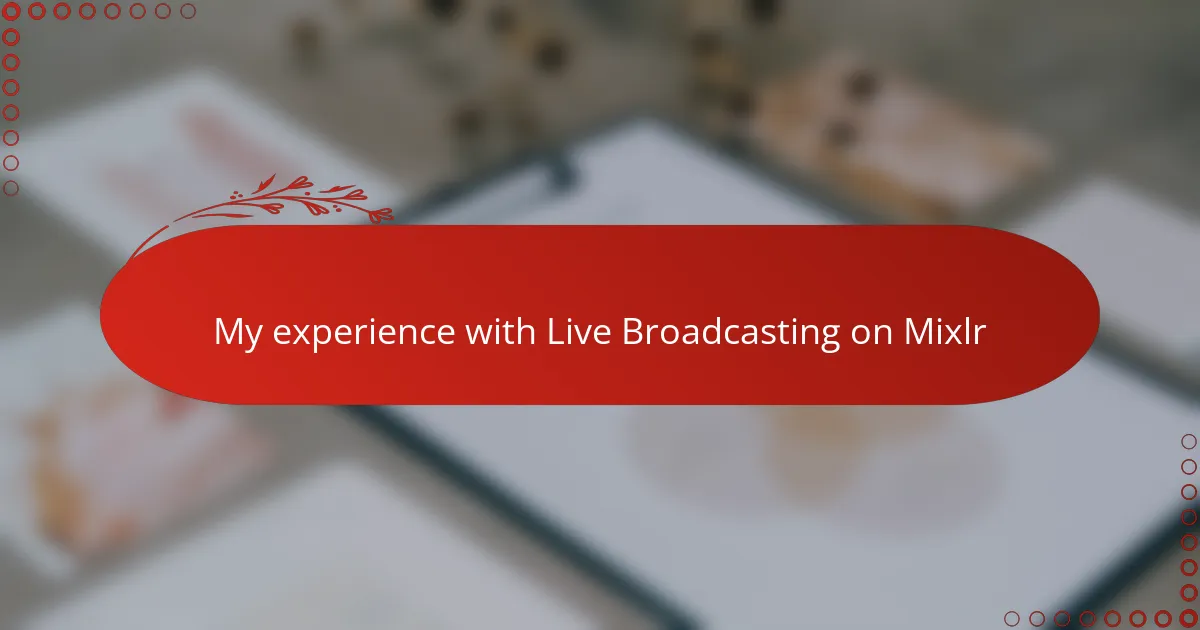Key takeaways
- Live radio broadcasting fosters spontaneity and connection with listeners, emphasizing the importance of staying present and adaptable.
- Mixlr’s user-friendly interface simplifies the broadcasting setup, allowing for flexibility in sharing different audio sources and engaging with audiences in real time.
- Effective audience engagement involves thoughtful pacing, active participation, and variety in content, enhancing the overall experience for listeners.
- Overcoming challenges like technical glitches and managing background noise is crucial for maintaining a smooth broadcast and nurturing authenticity in communication.
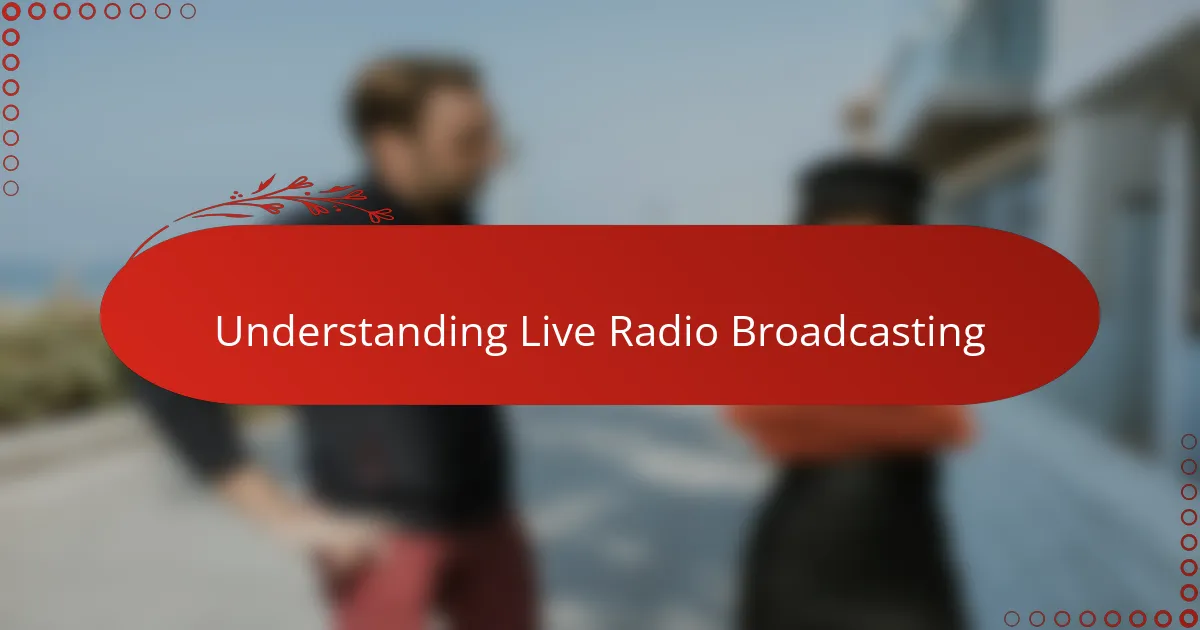
Understanding Live Radio Broadcasting
Live radio broadcasting is a unique dance of timing and spontaneity. I’ve found that unlike pre-recorded shows, every moment is unpredictable—there’s a raw energy knowing your voice reaches people in real time. Have you ever wondered what it’s like to share your thoughts without a pause button?
When I first started, I realized how crucial it is to stay present and adaptable. You can’t second-guess yourself because listeners pick up on hesitation. That immediate connection, even with strangers, is both thrilling and nerve-wracking.
At its core, live broadcasting is about storytelling on the fly. It demands not just technical know-how but also emotional presence. I’ve felt a deep satisfaction knowing my words were part of an unfolding moment, shared live with an audience somewhere out there.
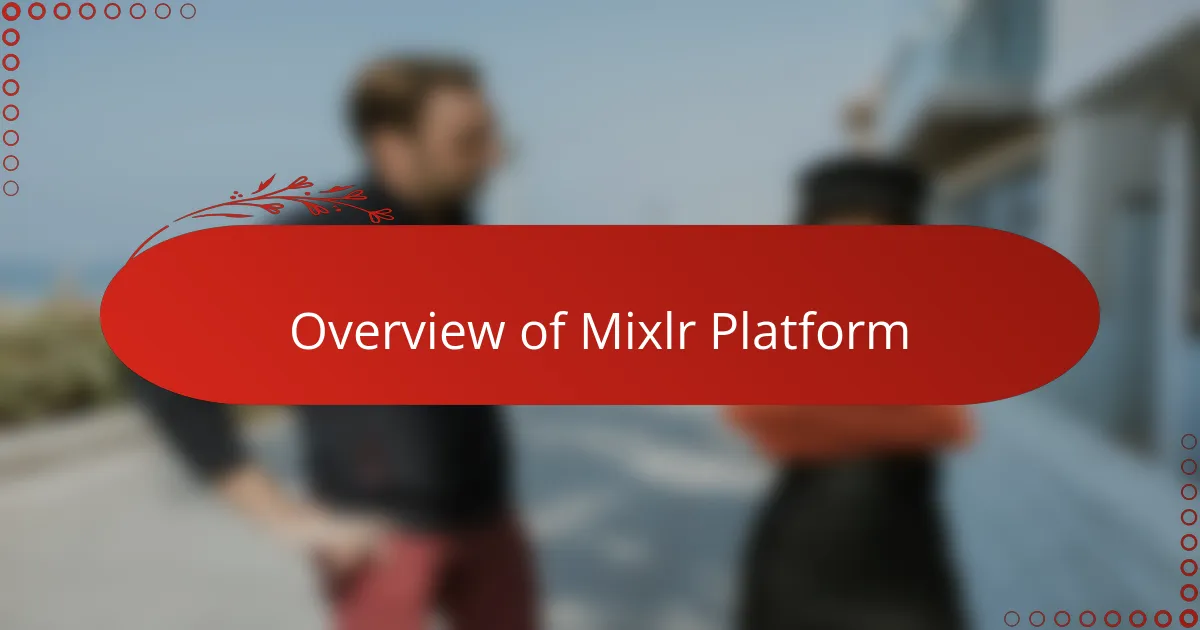
Overview of Mixlr Platform
Mixlr struck me as refreshingly straightforward when I first explored it. Unlike some broadcasting platforms that overwhelm with complex features, Mixlr offers a clean, user-friendly interface that made going live feel accessible from the get-go. Have you ever dreaded fiddling with complicated setups just to get on air? Mixlr eliminates that hassle by focusing on simplicity.
One thing I appreciated was how Mixlr supports both solo broadcasters and groups seamlessly. Whether I was sharing music, chatting with friends, or hosting live interviews, it handled multiple audio sources without a hitch. That flexibility made me feel like I wasn’t boxed into a single style of broadcasting.
What really stood out was the real-time interaction Mixlr enabled with listeners. Seeing people join, comment, and react as I spoke added a layer of connection that transformed the experience from just talking into a genuine conversation. It reminded me why live radio can be so compelling—it’s immediate, personal, and alive.
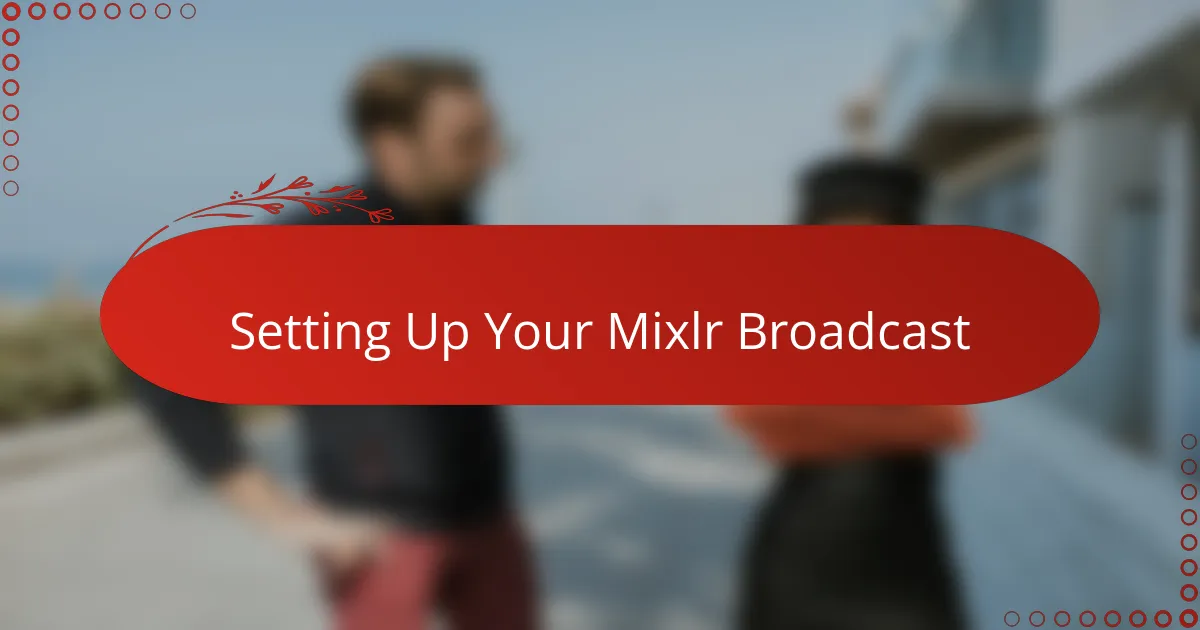
Setting Up Your Mixlr Broadcast
Getting started with Mixlr was surprisingly straightforward for me, which really eased my nerves. I remember just logging in, plugging in my microphone, and within minutes I was setting the broadcast title and selecting my audio source. Have you ever felt overwhelmed by tech? Mixlr’s setup felt like a breath of fresh air—simple and intuitive.
One moment that stuck with me was testing the sound levels before going live. Adjusting the volume sliders while listening to my own voice gave me a sense of control—I knew my listeners would hear me clearly without distortion. It wasn’t just technical prep; it was about crafting the first impression of my broadcast.
Mixlr also asks you to choose your broadcast’s privacy settings upfront, which I found helpful. Deciding whether to keep it public or just for friends made me pause and think about who I wanted to reach. That small step grounded me, turning a casual stream into something purposeful. Have you ever considered how audience intention shapes your on-air energy?
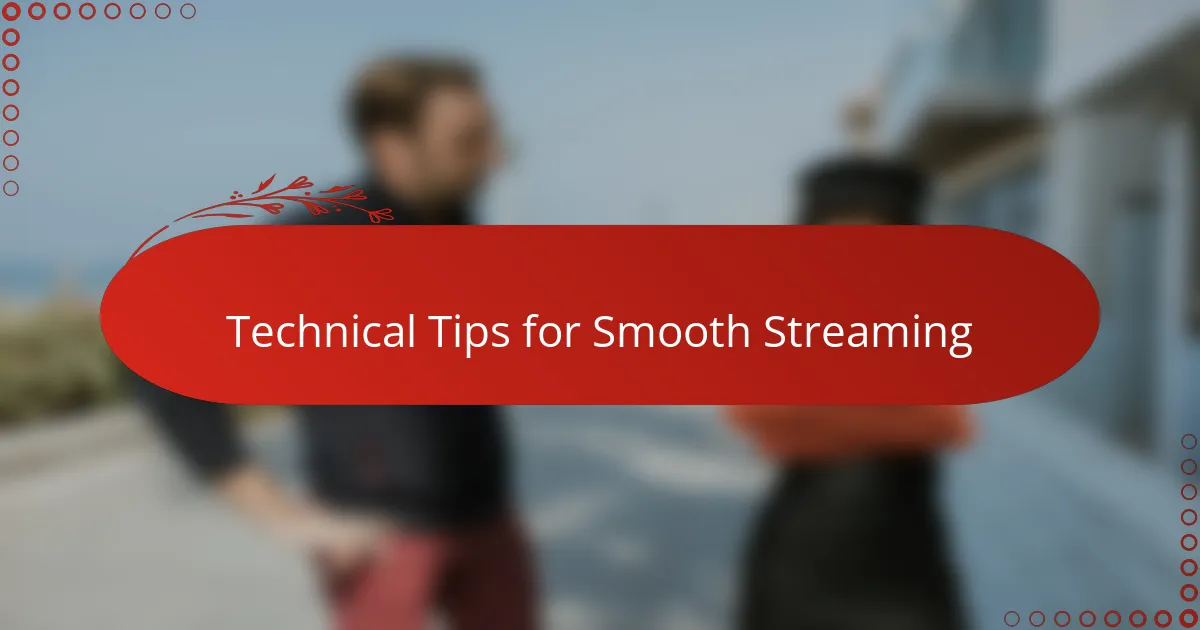
Technical Tips for Smooth Streaming
One thing I learned early on about streaming smoothly on Mixlr is the importance of a stable internet connection. I had a shaky start where my stream kept cutting out, and it was frustrating—not just for me but for listeners waiting to tune in. Have you ever sat through a broadcast that kept buffering? It kills the vibe instantly. After switching to a wired connection, my broadcasts were rock solid, and I could focus on content instead of tech glitches.
Another tip that made a world of difference was managing my audio input levels carefully. Too loud, and listeners get blasted; too soft, and they strain to hear you. I found myself constantly adjusting during shows until I realized setting a consistent baseline before going live made everything smoother. Mixlr’s volume meters became my best friend—I paid close attention to keeping those green bars steady without bouncing into the red. Trust me, your audience will thank you for that clear, balanced sound.
Lastly, don’t overlook the software side of things. I started with just my mic plugged in, but as soon as I added background music or remote guests, my CPU lagged and the stream stuttered. Upgrading my computer’s audio drivers and closing unnecessary apps instantly improved performance. It’s like prepping backstage before a live show: a little technical polish upfront prevents a messy on-air moment later. Have you checked what’s running behind the scenes on your device? It might be the quiet culprit behind those hiccups.
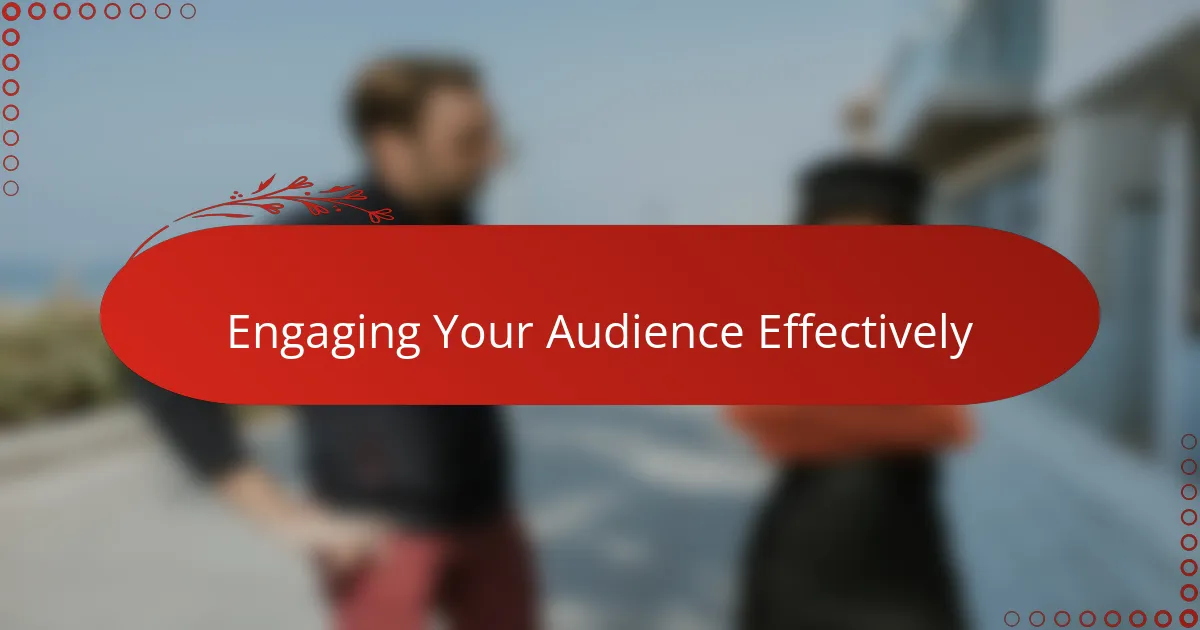
Engaging Your Audience Effectively
Engaging an audience on Mixlr felt like learning a new form of conversation—one where your listeners aren’t just passive listeners but active participants. I noticed how responding to their comments in real time made the broadcast feel alive, almost like we were all in the same room. Have you ever felt that spark of connection when a simple shout-out or a shared laugh reaches someone miles away?
I also realized that pacing and tone are everything. When I slowed down and used natural pauses, my listeners seemed more attentive, and the chat lit up with reactions. It’s funny how something as subtle as your voice’s rhythm can guide how engaged people stay. Do you ever catch yourself speeding through your words when nervous? Slowing down changed everything for me.
Lastly, variety kept my audience hooked—mixing music, stories, and even spontaneous Q&A sessions. It gave the broadcast a dynamic feel and made listeners eager for what came next. I found that planning loosely but leaving room for surprises helped me stay authentic and connected. Isn’t it exciting when a broadcast feels unscripted but intentional at the same time?

Challenges Faced During Broadcasting
One challenge I frequently faced was dealing with unexpected technical glitches mid-broadcast. There was this one time when my audio suddenly dropped out, and I had to stay calm while scrambling to fix it without losing my listeners’ attention. Have you ever experienced that heart-stopping moment when your equipment betrays you live on air? It’s a true test of composure.
Another hurdle was managing background noise, especially when broadcasting from home. I never realized how little sounds—like a creaky chair or a passing siren—could distract listeners until I noticed the chat slow down. It made me more mindful about my environment and the importance of creating a clean audio space. It’s surprising how much those small sounds impact the overall quality, isn’t it?
Lastly, I found it challenging to juggle engaging with live comments while staying focused on my content. Sometimes I was tempted to pause and respond too much, which interrupted the flow, but ignoring the chat felt cold. Finding that balance took time and patience. Have you ever wondered how broadcasters seem so natural while multitasking on a live stream? It’s definitely a skill that comes with practice.
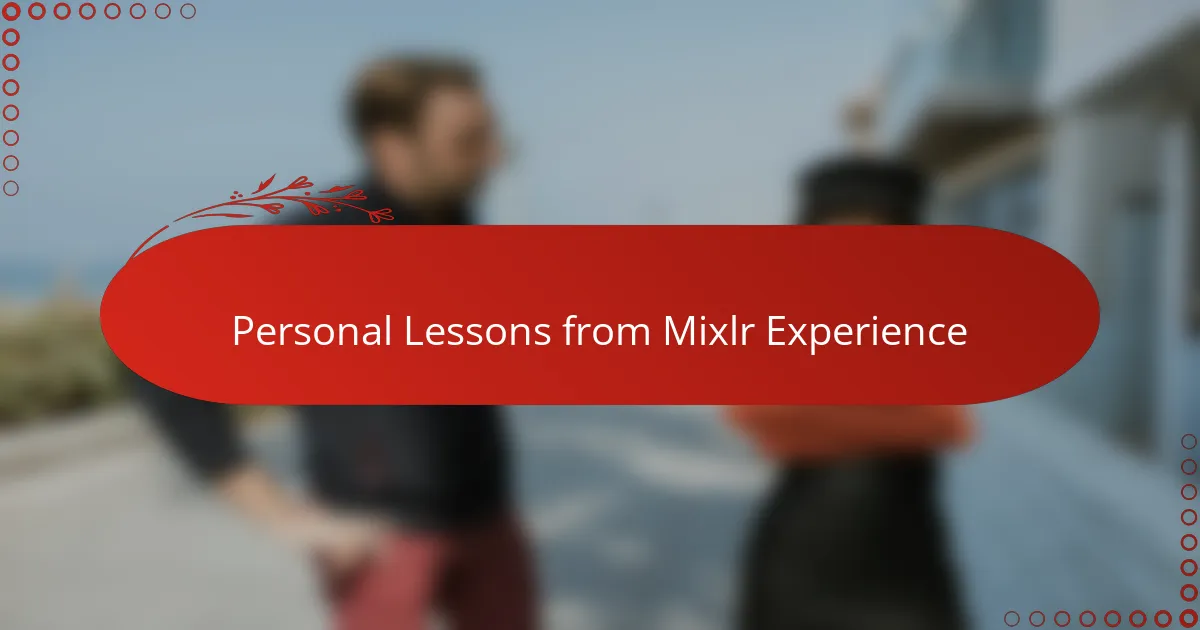
Personal Lessons from Mixlr Experience
One key lesson I took away from broadcasting on Mixlr is the value of patience with myself. Early on, I expected every show to flow perfectly, but that pressure just heightened my anxiety. Have you ever felt that weight of self-judgment live on air? Over time, I learned to embrace the imperfections—they made the experience more authentic and helped me connect with listeners on a human level.
Another realization was the importance of preparation without over-planning. I used to script everything to avoid awkward silences, but that approach made me sound robotic. When I loosened up, allowing room for spontaneity, the broadcasts felt more natural and engaging. It’s funny how giving yourself permission to be imperfect actually draws people in more.
Lastly, I discovered how vital it is to celebrate small milestones. That first compliment in the chat or a returning listener’s name felt like fuel for my motivation. Have you noticed how those little interactions can shift your entire mindset? They remind me why I keep choosing to go live on Mixlr despite the challenges—it’s about building a community one moment at a time.
